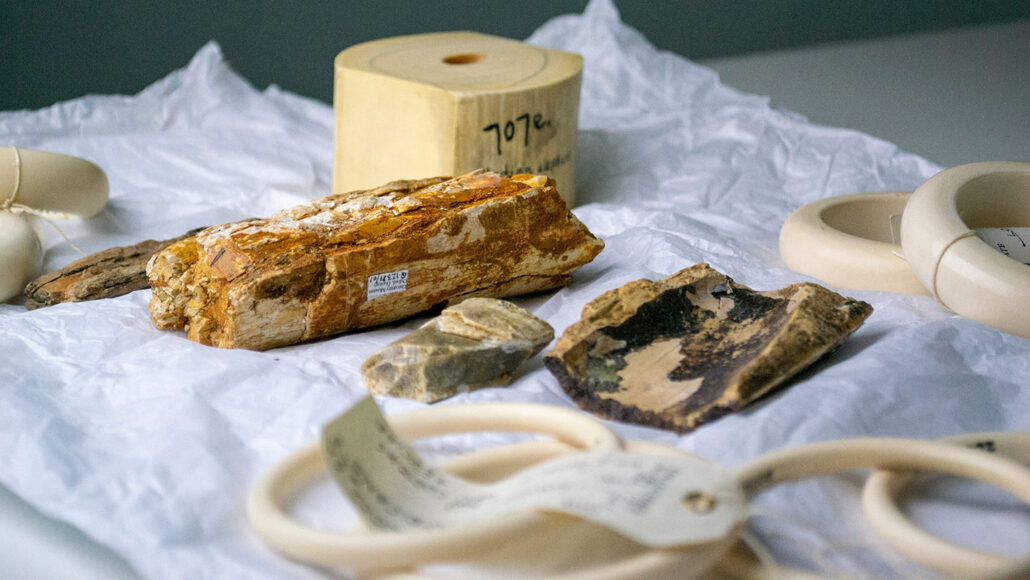Laser-based tech can identify illegal elephant ivory
It doesn’t damage the material — and it may deter poachers from trying to move ivory across borders

Ivory samples (above) look the same whether they’re from elephants or an extinct mammoth. But elephant ivory is usually illegal to sell, while mammoth ivory isn’t. A laser-based tool can tell the difference, which may help crack down on the illegal ivory trade.
Ben Booth, University of Bristol
Ivory is so popular that poachers regularly kill elephants for their tusks. To stop the slaughter of these animals, most nations banned the international sale of elephant ivory in 1989. Those laws have not totally stopped poachers. But lasers might, scientists now report.
Ivory is the hard material that makes up the tusks of several mammal species (both living and extinct). Selling ancient ivory, such as from a mastodon, is legal. So is the sale of elephant ivory that’s at least a century old (if you have the right documents to prove it’s that ancient). What’s illegal is newer elephant ivory.
Yet ivory from all of these animals looks about the same — at least to the eye.
And that’s proven a big problem. Poachers and other criminals can make lots of money from ivory. So many will lie about its source. The challenge for wildlife and customs officials is to know which ivory is which.

At the University of Bristol in England, scientists have just reported a new way to flag the illegal type. They use Raman spectroscopy (Spek-TRAAS-koh-pee). This chemical analysis, which involves lasers, is good for studying stuff that’s dense. And it’s been used for decades — just not to find poachers.
“Raman spectroscopy is well suited to identifying differences in materials that look similar but have different chemical compositions,” explains Eve Donnelly. This materials scientist at Cornell University in Ithaca, N.Y., knows that well. She uses the tool on human bones. She wants to see how they change with aging, disease or the use of certain medicines.
You just fire a laser at the material. That laser interacts with bonds that hold together the sample’s atoms. The reflected light reveals a “molecular fingerprint” of the material, Donnelly says. And that molecular signal reveals the identity of the sample.
Ivory and bone are similar, note the new study’s authors. So they decided to see if Raman spectroscopy could identify an ivory’s source.
And it does, reports Rebecca Shepherd. “We can use it to tell the difference between different elephant species [and their relatives].” That includes woolly mammoths. Shepherd, an anatomist, led the new study.
There are other, faster ways to analyze ivory for its source, Shepherd admits. However, Raman spectroscopy has an advantage. It can be done without destroying the sample.
Her team shared its findings April 24 in PLoS ONE.
The threat to elephants
At the beginning of the 1800s, tens of millions of elephants roamed Africa. By the time the ivory ban went into effect, elephants were endangered with extinction. Today, their populations have grown to a little more than 400,000, according to the World Wildlife Fund. So they’re no longer considered endangered. But ivory poachers still kill up to 15,000 elephants each year. These majestic animals therefore continue to face a threat of going extinct.
Mammoths did go extinct almost 4,000 years ago.
Remains from some of them of have been found in Siberia, preserved in permafrost. But global warming has been melting that permafrost. Today, people search the world for mammoth carcasses and their ivory.
Mammoth ivory and elephant ivory look the same. And that’s where the new technique can help. For the source of ivory, “whether living or extinct, we can tell the difference,” says Shepherd.
She says she plans to extend her research. She wants to adapt it to identify bone or teeth from other animals. Those include narwhals and sperm whales.
She’s also working with the World Wildlife Fund to explore how to stop poachers. She hopes the laser method will be integrated into portable devices that border guards already use to test ivory.
“I’d also like to create a large database of ivory samples and have this freely available,” says Shepherd. Then, a piece of software could compare a new sample to known ones. This should indicate how likely the ivory is to have come from an illegal source. “It’d be a really good first test,” she says.
Do you have a science question? We can help!
Submit your question here, and we might answer it an upcoming issue of Science News Explores







